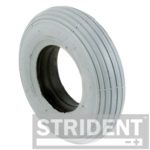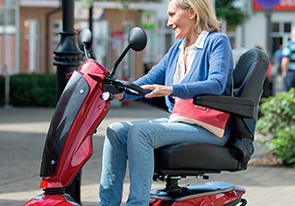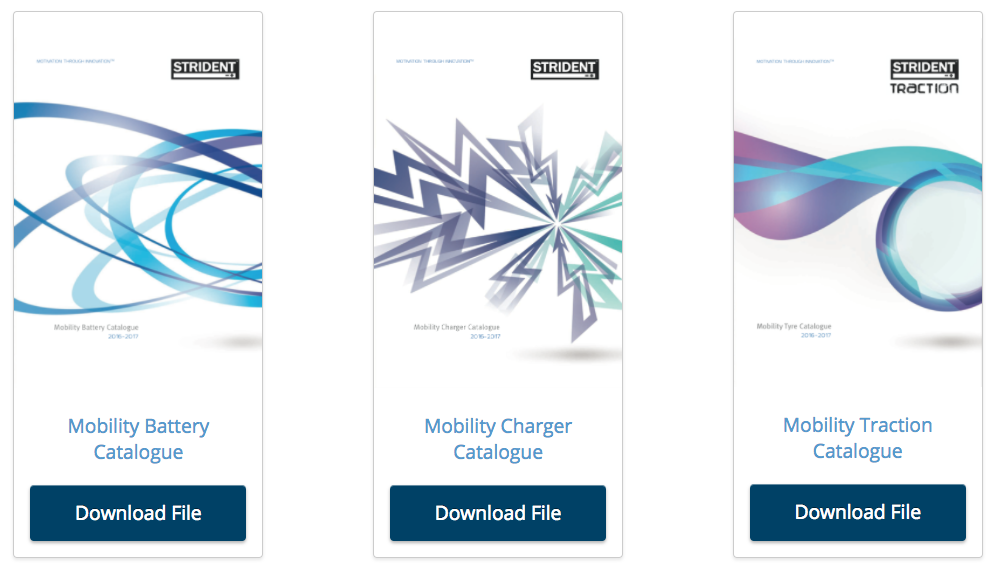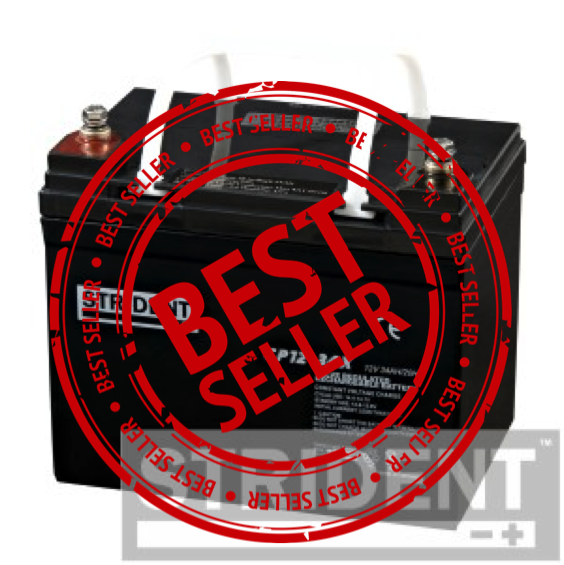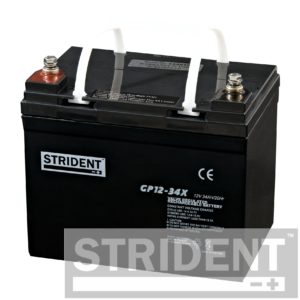Mobility scooter tyres: when traction really matters talk to Strident
It's cold times like this is when traction really does matter
 When the weather is icy and snowy traction becomes a much more important factor in the performance of your mobility scooter tyres. It is then that you realise that low traction may not always be worn down tread?
When the weather is icy and snowy traction becomes a much more important factor in the performance of your mobility scooter tyres. It is then that you realise that low traction may not always be worn down tread?
From experience in the mobility market worn tread is, of course, the most obvious reason for low traction in the normal course of things. Often, however, we see there are underlying reasons for premature tyre wear.
What do you think about the root causes of low traction during in-climate weather conditions? Why not drop us an email and tell us what your experience is.
If you are having traction problems with your mobility scooter tyres then why not take a look at our:
Strident's solid tyres range are divided into grey solid tyres and black solid tyres
Strident's pneumatic tyres range are divided into grey pneumatic tyres and black pneumatic tyres
We also stock wheelchair tyres (Grey PU)
Or, finally, if you have a repair to make check out our range of inner tubes.
24v 5Amp Mobility Scooter Battery Charger Review
If you are looking for a 24v 5Amp mobility scooter battery charger, then here is a review of one of Strident Batteries' most popular products - the Strident CHE Charger CHE24-5. This is one of the top selling battery chargers in the Strident range and is recognised by mobility and disability equipment installers and maintenance companies for some industry leading features.
But aren't all 24-volt battery chargers the same?
Are all battery chargers the same? We don't think so - and given the vital role of a mobility scooter battery charger, we believe users need to have peace of mind that they can get the very best from their batteries. In addition to the quality of the battery itself, the battery charger plays a key role in achieving optimum battery performance.
What does a 24-volt battery charger need to offer in a mobility or medical setting?
The main factors that relate to the requirements for mobility and medical batteries:
1. Correct levels of charge need to be applied to every stage of recharging
2. Eliminate any risk of gassing caused by overcharging
3. The recharging process doesn't damage the battery plates
How does Strident’s 24v 5Amp scooter battery recharger meet those requirements?
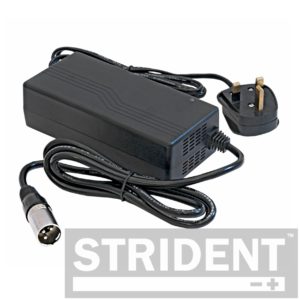
All Strident Battery chargers use an intelligent three-stage charging process in order to meet all of the requirements listed above. The three stages are:
Stage 1: Bulk Charge
Where charging current is set to the maximum safety level. Continuing until the voltage has increased to 80 – 90% of the full charge level.
Stage 2: Absorption Charge
The charging voltage remains constant, whilst the current reduces due to the increase in internal resistance. It is during this stage that the charging voltage is at its highest.
Stage 3: Float Charge
Once the battery has reached optimum charge level this final stage helps to increase the longevity of the battery because the charging voltage and current is significantly reduced which maintains the battery at peak charge. Through the units intelligent monitoring of the battery condition this final and critical stage reduces the risk of gassing and minimises the possibility of self-discharge.
Through utilising our range of chargers you can be assured that your batteries are being charged, conditioned, and maintained to ensure peak performance and longevity.
Strident Service on top of the technology
In addition to our range of batteries, chargers, and traction products, Strident provides a very high level of service. If, for example, you would like any help identifying exactly the right product, then just call us on 01362 300102. One of our experts can talk you through all the options.
Please visit our Product page for details and enquiries or in order to arrange a callback.
The 7 Essential Rules for operating Mobility scooters and powered wheelchairs
If you are new to mobility scooters or powered wheelchairs – or a family member or close friend is just about to acquire one – here is our quick 7 essential rules for legally and safely heading out and about.
Rule #1 – You may need to register your scooter
Whilst you don’t need a driving licence to drive a mobility scooter or powered wheelchair, you may well have to register it. Broadly there are two categories:
- class 2 invalid carriages – which cannot be used on the road (unless there is no pavement). These have a maximum speed of 4mph.
class 3 invalid carriages - can be used on the road, and have a maximum speed of 4mph off the road, and 8mph when driven on the road. You must be 14 or over to drive a class 3 invalid carriage.
You don’t need to register a class 2 invalid carriage.
You do need to register class 3 invalid carriages.
Rule #2 – Make sure your class 3 invalid carriage has the following:
- maximum weight (unloaded) of 150kg
- maximum speed of 8mph and a device to limit its speed to 4mph
- maximum width of 0.85 metres
- working and efficient brakes
- front and rear lights and reflectors
- hazard warning lights function
- horn loud enough to be heard clearly
- rear view mirror
- an amber flashing light if it’s used on a dual carriageway
Please make sure you have all of these as the police could stop you if your class 3 scooter or powered wheelchair doesn’t have these features.
Rule #3 – What to do/not do when driving on a road
First, remember that you can only drive on the in a class 3 invalid carriage and that the maximum speed is 8mph. Follow the Highway Code at all times.
You can’t drive on bus lanes, cycle lanes or motorways.
Don’t use dual carriageways with a speed limit of over 50mph. If you go on a dual carriageway use an amber flashing light for visibility.
Rule #4 – Freedom to drive on footpaths and parking
All mobility scooters and powered wheelchairs can legally travel at a maximum of 4mph on footpaths or in pedestrian areas.
Please keep off cycle paths marked ‘cycle only’.
Rule #5 – Considerate Parking
Consider your scooter or powered wheelchair as you would a car. All normal parking restrictions apply.
Your vehicle shouldn’t be left on a footpath or pedestrian area on its own if it gets in the way of other pedestrians, including wheelchair users and people with prams or pushchairs.
Rule #6 - Who can use a mobility scooter or powered wheelchair
- anyone who has trouble walking because of an injury, physical disability, or medical condition
- if you are demonstrating the vehicle to a potential buyer
- if you are conducting training for a disabled user
- if you are taking the scooter or wheelchair to or from maintenance or repair
Rule #7 - No vehicle tax but remember registration and insurance
You’ll be glad to hear that there is no vehicle tax for any mobility scooter or powered wheelchair. Do see rule #1 about needing to register class 3 invalid carriages.
To register a class 3 invalid carriage, complete form V55/4 for new vehicles, or V55/5 for used vehicles. Download either of these forms from the DVLA’s online ordering service. Follow the instructions and return the form by post (currently the only option).
Insurance: Whilst you don’t actually need insurance for a mobility scooter or powered wheelchair, it is strongly recommended in case of any accident.
Maintenance
In addition to all this great guidance, do please keep you Mobility Scooter well maintained. If you are looking for new batteries, chargers or tyres for your mobility scooter, take a look at our catalogues page. Click the image below to take you there.
12v 34ah mobility battery – the UK’s most popular?
As we near the end of the year, we will now start to see all the lists of “top things in 2016”. So, we are going to strike first and declare the 12v 34ah mobility battery THE most popular battery for the mobility vehicle market.
Whilst we won’t pretend to have done a statistically representative poll of the whole market, we have seen the 12v 34ah battery consistently be our best seller through our large network of mobility distributors. So why is this?
First of all due to Scooter Manufacturers
The first simple reason for this high demand is that the 12v 34ah is one of the most popular industry standard batteries that mobility scooter manufacturers put on their vehicles. They specify such a deep cycle rechargeable battery to match the typical pattern of use that a mobility scooter gets.
Secondly - The balance of power output and length of operation
If you think of the contrast between a car battery and a mobility scooter battery, the car battery is used predominantly for a short burst of high energy to start the car. This kind of battery is never propelling the car!
A mobility scooter, however, has a different requirement and the battery is typically going to be for a more constant use e.g. driving the scooter from a house to local shops or for a visit to friends and family. The battery is, of course, propelling the vehicle, which takes a certain amount of energy to achieve.
For the average user weight and travelling distance required, the 12volt battery rated at 34 amp hours (AH) would suffice in the majority of applications
Performance vs Budget
Finally, we believe the popularity of this 12v 34ah battery is due to the match between performance and cost. There are always more powerful batteries but costs start to rise. Cheaper batteries either don’t hold the charge or don’t deliver enough operating time to make them a good choice. So the 12v 34ah does seem to be in a good price/performance place for the average scooter.
Why use Strident’s 12v 34ah mobility battery
Take a look on our batteries page to see an outline of the key features of our batteries that make them work so well with mobility scooters, our range of high performing medical batteries extends to other medical devices like patient hoists. There are a few things in our design that optimise battery performance and life.
Specific details of our best seller can be clicking the image below:
12v 7ah Battery Product Review – for Mobility Applications
If you are looking for a 12v 7ah rated AGM Battery for use with a Mobility Scooter or Medical Hoist, then here is a review of the Strident Batteries AGM GP12-7. This is one of the best selling batteries in the Strident range and recognised by mobility and disability equipment installers and maintenance companies for some industry leading features.
But all 12 volt batteries are the same…aren’t they?
What is the purpose of a review if every battery is the same? Well, if you consider that these standard valve regulated lead acid rechargeable batteries were first launched in the 1970’s, you won’t be surprised that there design and performance has evolved somewhat since then.
What does a 12 volt rechargeable battery need to offer in a mobility or medical setting?
There are 3 main factors that feature in the requirements for mobility and medical batteries:
1. The ability to sustain high demands of constant use
2. Being able to perform a high number of operational cycles
3. Trust from dependent users that it will perform when and where it is needed
How does Strident’s 12v 7ah battery meet those requirements?
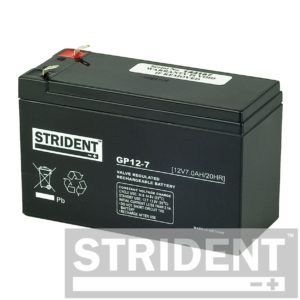
- Valve Regulated. The performance of the valve equipment is to key to the effectiveness and longevity of a battery – particularly when it comes to charging. Strident use the highest specification for optimal venting.
- Quality Control. A stringent testing procedure at both point of manufacture and point of despatch is essential. The second check is as crucial as the first and so Strident test each battery going out of its automated central warehouse.
- Plate Separator. All high performing batteries need to have a plate separator system for increased efficiency and longevity. Strident use a superior quality glass matting separator in all AGM batteries and high performing polymer in Gel battery range.
- Plate Composition. To give maximum performance during both cyclic and standby applications, Strident use a purified lead blended with critical conductive properties.
Strident Service on top of the technology
If the technical review of our 12v 7ah battery is not enough information, then we can also share this review of the whole Strident experience from a recent customer.
I chose this mobility battery for 3 reasons. Reasonably priced, fast delivery (also here when they were meant to be), and finally – VERY good quality! No problems with recharging them and they are fully charged in about 3 hours.
Thanks so very much.
AS June 2016
Please visit our Product page for details and enquiries or in order to arrange a callback.
What are Lead Crystal Batteries?
Those of you who’ve shopped online for batteries before, are probably familiar with AGM, Gel and small-cell batteries. But you may not have come across Lead Crystal Batteries as possible power solutions.
But what are lead crystal batteries, and what makes them worth considering for your application?

There are a number of great benefits to these power sources, which make them an excellent choice in a number of situations. As a result, they’re commonly used today in telecommunications, wind and solar power, healthcare, manufacturing and electric vehicles.
Firstly, they can be charged faster than most conventional batteries and be safely discharged to 0 volts without being put under stress. They can also be discharged more often and will comfortably operate between extreme temperatures of -40 to 65C (making them great for regular use in harsh environments.) And incredibly, they require no extra ventilation or cooling to operate under these conditions.
They’re also much safer than many other battery types in both their day-to-day use and in the long term. As they use less acid and no cadmium or antimony, this reduces the risk of harmful leakage, and they’re up to 99% recyclable depending on the make and model.
This reduced risk even results in lead crystal batteries being classified as non-hazardous for transport, reducing potential issues that might arise when travelling internationally.

The batteries’ overall resilience means they boast a float service life of up to 18 years and can be stored for up to two years without needing to be refreshed or recharged.
If you’re unsure if lead crystal battery power is right for your product or application, don’t hesitate to ask the team here at Ivanhoe. With over 15 years of direct experience with battery power, our knowledgeable staff are happy to help you make an informed decision.
You can get in touch with us directly on 0845 555 5511, or message us via the contact page. For more information on our products, including charging accessories, you can download one of our brochures here.

